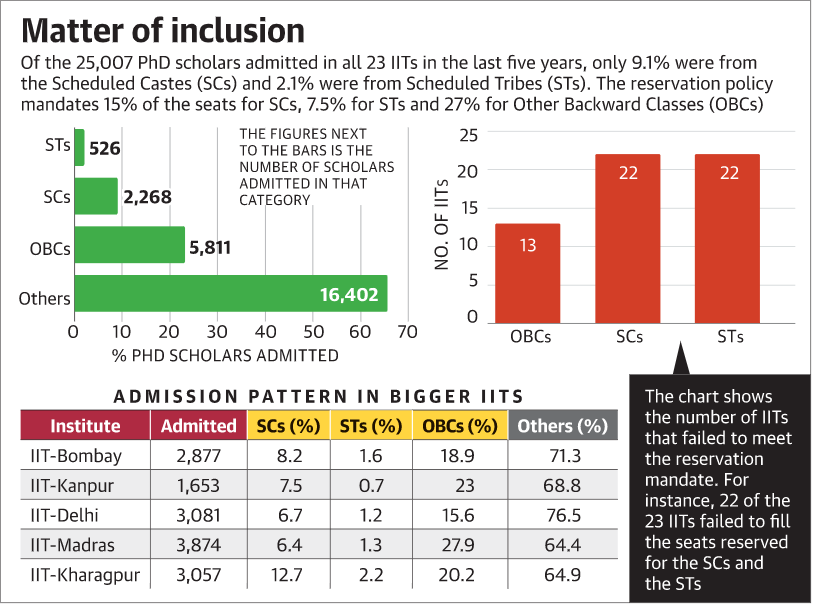Social Justice
Falling Numbers of SC & ST Students in IITs
- 15 Feb 2021
- 5 min read
Why in News
Recently, data collected from a series of Right to Information (RTI) applications pertaining to five older Indian Institutes of Technology (IITs), has indicated that the acceptance rate is skewed against students from the Scheduled Caste (SC), Scheduled Tribe (ST), and Other Backward Classes (OBC) communities.
- SC and ST applicants are half as likely to get selected for a Ph.D. programme at IITs as aspirants from the General Category (GC) are.
Key Points
- Data from the RTI Applications:
- Acceptance Rate:
- It refers to the number of students selected for every 100 students who applied.
- It stood at 4% for students from General Category (GC).
- It falls to 2.7% for OBC students and further down to just 2.16% for SCs and 2.2% for STs.
- This finding comes against the backdrop of the Education Ministry’s data submitted to Parliament in 2020 showing the failure of the IITs to fill Ph.D. seats as per reservation.
- The government’s reservation policy mandates allocation of 15% seats for students from the SCs, 7.5% from STs and 27% from OBCs.
- It refers to the number of students selected for every 100 students who applied.
- Significance:
- The IITs have often cited the lack of applicants from the marginalised communities for the situation. However, the RTI data reveals quite the opposite.
- The percentage of GC students among those admitted was always higher than their percentage among those applied. However, the converse was true for SC, ST and OBC candidates.
- Acceptance Rate:
- Education Ministry's Data:
- Of the total admissions made by all IITs from 2015 to 2019, only 9.1% went to SC and 2.1% to ST.
- Only 23.2% seats went to applicants from the OBCs. Remaining 65.6%, or roughly two-thirds of all the seats, went to General Category applicants.
- Reasons for Falling Rate:
- Given by IITs:
- Eligibility Issue:
- Some institutions could not even fill all the seats in the general category since they did not get enough eligible candidates.
- Economic Causes:
- Students of the required calibre tend to take up industry jobs rather than join for a PhD which has extra uncertainties and lower income levels during PhD and in some areas even post PhD.
- It is possible that the family background and economic level may have an impact on such candidates applying for a PhD.
- Eligibility Issue:
- Argument of 'Merit':
- There has been long-standing opposition among IIT administrators and faculty to reservations, which they see as a form of unjust government intervention in their meritocratic institutions.
- The recent report of an Education Ministry-constituted committee recommended the abolition of reservation in faculty recruitment.
- The committee based its recommendations primarily on arguments claiming the need for IITs to maintain their academic excellence and the lack of candidates from the reserved categories who fulfil the qualification criteria.
- A More Systematic Problem:
- The problem is also of practice and access to quality school education, leading to poor base.
- Given by IITs:
- Advantages of following the Reservation Policy:
- An Example to Other Institutions:
- The IITs are and should continue to be institutions of national importance. But they also have social functions.
- They should set an example to other institutions by creating opportunities for and encourage the underprivileged communities to excel in research and innovation.
- Bridging Inequalities:
- Affirmative action and caste-based reservation can help bridge inequalities in society, enable the underprivileged to have access to quality education, promote diversity, and, more importantly, remove obstacles to equality and correct the past wrongs.
- An Example to Other Institutions:
Way Forward
- Policy intervention has to begin sooner, in the early school years, to attempt to equalise opportunities in education.
- In addition, negative attitudes, perceptions and stereotypes about the ability of students belonging to the SC/ST groups are a major hurdle. Policy should recognise how such perceptions hold back individuals and groups, and seriously attempt to think of ways to alter these.
- Diversity issues can also be addressed through outreach campaigns.







